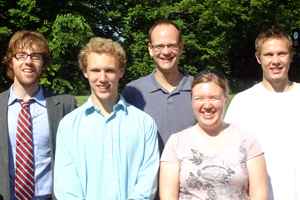Note: This article is over a year old and information contained in it may no longer be accurate. Please use the contact information in the lower-left corner to verify any information in this article.
August 16, 2012

St. Olaf College Associate Professor of Physics Brian Borovsky ’94 and a team of student researchers recently presented their findings on the frictional properties of metal oxides at the prestigious Gordon Research Conference on Tribology.
The team — which includes St. Olaf students Trevor Knapp ’13 and Lucas Sletten ’15 as well as Luther College Associate Professor of Physics Erin Flater and student Erik Linn-Molin and a group of chemical engineers at Auburn University — looked at whether metal oxides could be used to construct microscopic machines.
These delicate machines, smaller than the width of a hair and already used in everything from smartphones to Nintendo Wii remotes, need to be constructed using a low-friction material.
“Engineers would love to design much more complicated mechanical devices that are microscopic in size, containing gears and pistons and other familiar machine components, but they will likely need different materials to work with,” Borovsky says. “That is where our project comes in.”
Funded by the National Science Foundation and conducted as part of St. Olaf’s Collaborative Undergraduate Research and Inquiry (CURI) program, their research is part of a multi-year project that aims to discover a material and lubricant combination ideal for creating micromachines. To find that combination, they’re examining what causes friction in various materials and how it can be reduced most effectively using the thinnest possible lubricant layer.
“We will need to know a lot more about the fundamental physics of surfaces before ultra small machines will be able to really burst on the scene,” Borovsky says. “But the impact on our daily lives could be huge. Communications technology, environmental monitoring for safety and sustainability, and even medical care could be significantly improved by applications made possible with micromachines.”
Borovsky and his research team presented their findings at the Gordon Conference, a gathering of about 100 scientists and engineers from around the world who each study friction in some way. The St. Olaf team members were among a select few undergraduates at the conference, which gave them the opportunity to interact with preeminent scientists and engineers in tribology.
That, combined with the work they’ve done on campus, resulted in an invaluable research experience.
“The part about my summer research that I enjoyed the most was the great sense of community we had in the Physics Department,” says Knapp. “Every Wednesday, we would get together as a group and hear stories about the latest finds in the field of physics, or learn about life as a graduate student, or just hear great stories from our professors.”
Borovsky says having students involved in the research is a win-win situation.
“Students help advance the research project while gaining a truly hands-on introduction to life as a scientist,” says Borovsky. “As a faculty member, I enjoy seeing the huge impact that real research experience has on my students, and as a complement to classes and textbook learning, it really can’t be beat.”
You must be logged in to post a comment.